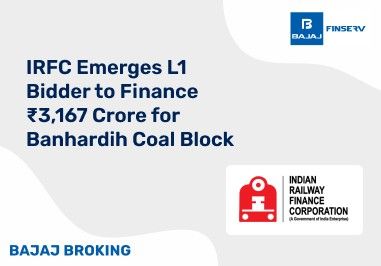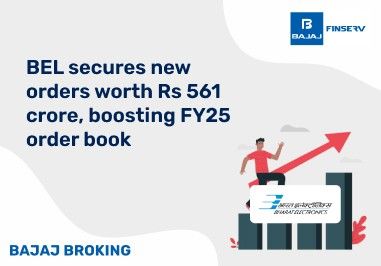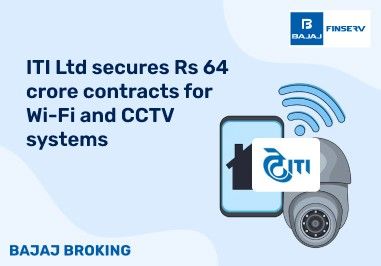BAJAJ BROKING
Laxmi Dental IPO is Open!
Open a Free Demat Account
Trade Now, Pay Later with up to 4x
Track Market Movers Instantly
Share Market Today | Gift Nifty Signals Flat Indian Market Opening Amid Mixed Cues
Synopsis:
Today’s share market’s key updates include how HDFC Life refutes bancassurance regulation rumours, PC Jeweller announces share split, Emami Realty unveils ₹15,000 crore plans, Hindalco expands Sambalpur smelter, FIIs net sell ₹11,756 crore as DIIs buy ₹8,718 crore.
Latest Market News
1. HDFC Life Insurance Co.: The company has addressed media reports regarding changes to bancassurance regulations by IRDAI. It clarified that consultations with the industry usually precede regulatory changes of this nature.
2. PC Jeweller: The company has set Dec. 16 as the record date for the 10-for-1 share split.
3. EmamiRealty plans 22 msf dvpt having revenue potential of ₹15,000 cr, total est invest at ₹10,000 cr.
4. HINDALCO IND; Odisha approves Hindalco’s ₹10,645 crore plan to expand Sambalpur smelter to 0.68 MTPA.
5. FIIs net sell ₹11,756.25 crore while DIIs net buy ₹8,718.30 crore in equities yesterday.
[-]
Trade[-][-] ([-] %)
In-Depth Market Insights: Global Outlook, Derivatives & More
US Share Market News
Performance Overview:
The US market was closed yesterday.
Wall Street is set for a shortened trading day on Friday.
Sector-Specific Movements:
The S&P 500, NASDAQ Composite and Dow Jones Industrial Average were trading up between 5% and 7% for November, having rallied to a series of record highs in the wake of a Trump election victory. The Dow was the best performer among its peers.
Focus in the coming week will be on comments from a slew of Fed officials, including Chair Jerome Powell on Wednesday, for more cues on interest rates.
The Fed is set to meet on December 17 and 18 in its final meeting for the year.
Economic Indicators:
Despite recent signs of sticky inflation and labor market strength, markets have largely maintained expectations for a 25 basis point cut in December. The cut will bring the Fed’s total rate cuts in 2024 to 100 bps.
Other Asset Classes
Commodities:
Gold prices slipped on Thursday as the U.S. dollar strengthened, while investors assessed a flurry of economic data showing stalled inflation progress, suggesting the Federal Reserve might tread cautiously on further interest rate cuts.
Spot gold fell 0.3% to $2,627.60 per ounce.
Oil prices edged lower in Asian trading on Thursday. Brent crude futures fell marginally by 0.1%, to $72.79 per barrel.
Asian Markets
General Trends:
Asia-Pacific markets started Friday lower, with investors assessing November inflation numbers from Japan’s capital of Tokyo and industrial production figures from South Korea.
Specific Index Performance:
Japan’s Nikkei 225 fell 0.72% after the inflation data release, while the broad-based Topix was 0.50% lower.
South Korea’s Kospi led losses in the region, down 1.38%, while the small-cap Kosdaq was over 1% lower.
India Market Outlook
GIFT Nifty Projection:
Gift Nifty suggests a flat opening for the Indian market amid mixed Asian cues. Nifty spot is likely to consolidate in the range of 23700-24100 after yesterday's sharp decline.
Market in Previous Session:
Indian equity markets witnessed a sharp selloff on Thursday as benchmark indices Sensex and Nifty declined nearly 1.5%, in the steepest single-day fall in nearly 2 months. A combination of geo-political tension, profit-booking ahead of the monthly F&O expiry, and sectoral pressures led by IT and auto stocks weighed on sentiment.
At close, the Sensex was down 1,190.34 points or 1.48 per cent at 79,043.74, and the Nifty was down 360.70 points or 1.49 per cent at 23,914.20. Despite the decline, market breadth stayed marginally positive, with 2,156 shares advancing against 1,632 declining.
On the sectoral front PSU bank stocks saw buying interest, while I.T and auto stocks were under selling pressure.
Bank Nifty after initial positive momentum gave up its gains and closed the session firmly lower at 51906 levels down by 0.76%.
Nifty Short-Term Outlook:
The Index has formed a sizable bear candle with a lower high and lower low signaling sharp selling pressure at higher levels around 50 days EMA contrary to our expectations. Index in the process filled the gap up area of Monday.
The 24,350-24400 level serves as a critical resistance for Nifty, with the index repeatedly failing to breach it in the last 4 trading sessions.
Nifty is currently placed at the support area of 23,900-23,700 being the 50% retracement of the recent pullback (23263-24354) and recent trendline breakout area.
We believe the index holding above the support area will lead to a pullback towards the 24300-24400 levels in the coming week being the being the confluence of the 50 days EMA and the current week high. Failure to do so will lead to an extended decline towards 23300 levels.
Intraday Levels:
Nifty: Intraday resistance is at 24,070 followed by 24,200 levels. Conversely, downside support is located at 23,800, followed by 23,670.
Bank Nifty: Intraday resistance is positioned at 52,230, followed by 52,550, while downside support is found at 51,600, followed by 51,400.
Derivative Market Analysis
Nifty:
The interesting data point to note is that the highest put OI addition has been observed at the 23,000 level, whereas immediate put OI is positioned at the 24,000 level. If the price holds below 24,000, a corrective bias may be witnessed.
Across strikes above 24,000, up to 24,500, call OI addition has been observed, suggesting multiple resistance levels and a limited upside.
According to option chain analysis, put writers have shifted their positions to lower levels, indicating caution regarding a potential downside movement. The immediate range for Nifty is between 23,500 and 24,000.
The Nifty put-call ratio has declined by 0.17 and is now positioned at 0.95.
Bank Nifty:
The highest call OI addition has been observed at the 53,000 level, which will serve as immediate resistance. If the price surpasses and sustains above 53,000, short covering may be witnessed.
On the flipside , put writers have shifted their positions to lower levels. Immediate put OI addition has been noted at the 52,500 level. If the price holds below this level, a corrective bias toward 51,500 may be seen in the upcoming sessions.
According to the option chain, the broader range for Bank Nifty is between 51,500 and 53,000.
The Bank Nifty put-call ratio has declined by 0.20 and is now positioned at 0.86.
Stay on top of the latest market news with Bajaj Broking’s insights. Our point-to-point expert analysis digs deep into the surface, empowering you with a unique perspective on domestic and global stock market events. Get all the current share market news, including US share market updates in one place and make wise investment decisions.
Disclaimer: Investments in the securities market are subject to market risk, read all related documents carefully before investing.
This content is for educational purposes only. Securities quoted are exemplary and not recommendatory.
For All Disclaimers Click Here: https://bit.ly/3Tcsfuc
- Related Articles
- Top Articles

Gold Rate Today | 15 January 2025 | Gold Price in India
15 Jan, 2025 | 40 Min. read

Delhi Court Discharges JSW Steel in Corruption Case; HC Clears Monnet Takeover
15 Jan, 2025 | 2 Min. read

IRFC Emerges L1 Bidder to Finance ₹3,167 Crore for Banhardih Coal Block
15 Jan, 2025 | 2 Min. read

Cipla’s Tax Demand Reduced to ₹559.18 Crores After Revision
15 Jan, 2025 | 2 Min. read

Govt Plans 5-6% Hike in Highway Budget for FY26 After FY25 Slump
15 Jan, 2025 | 2 Min. read

Rikhav Securities IPO- Key Objective & Deep Analysis
15 Jan, 2025 | 5 Min. read

HCL Tech expands partnership with Microsoft to transform contact centres
14 Jan, 2025 | 2 Min. read

BEL secures new orders worth Rs 561 crore, boosting FY25 order book
14 Jan, 2025 | 2 Min. read

ITI Ltd secures Rs 64 crore contracts for Wi-Fi and CCTV systems
14 Jan, 2025 | 2 Min. read

JSW Energy secures LoI for 3.6 GW KSK Mahanadi power plant
14 Jan, 2025 | 2 Min. read

Biocon Biologics’ Johor Bahru Facility Receives FDA VAI Classification
13 Jan, 2025 | 2 Min. read

Interarch Secures ₹221 Crore Projects in Semiconductors & Energy Storage
13 Jan, 2025 | 2 Min. read

RBI Launches ULI: Transforming Loan Access
August 27, 2024 | 4 Min. read

Textile Sector in India
September 20, 2024 | 5 Min. read

List of IPOs with DRHPs Filed
November 30, 2023 | 3 Min. read

Aditya Birla Group
September 28, 2023 | 10 Min. read

Bajaj Housing Finance Ltd IPO: Things Smart Investors Need to Know
September 05, 2024 | 4 Min. read

Budget Stock Ideas 2024-2025 | Stocks to Buy Today
July 24, 2024 | 4 Min. read

IPO Eligibility Criteria : Full Details
March 15, 2024 | 6 Min. read

What Is the Lock-In Period in IPOs?
October 18, 2023 | 6 Min. read

Godfrey Phillips Announces 2:1 Bonus Shares
September 16, 2024 | 7 Min. read

Jindal Group- A Comprehensive Analysis
September 27, 2024 | 7 Min. read
Read More Blogs
Our Secure Trading Platforms
Level up your stock market experience: Download the Bajaj Broking App for effortless investing and trading



